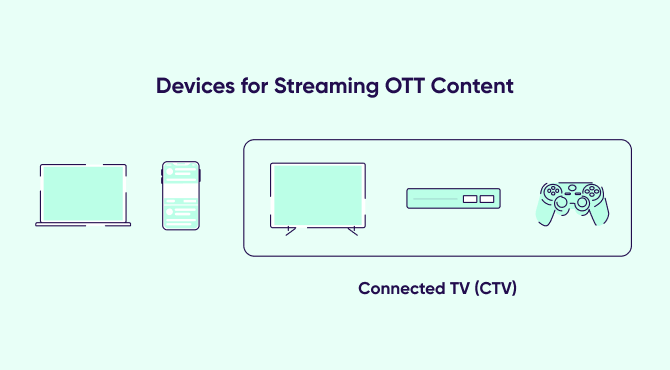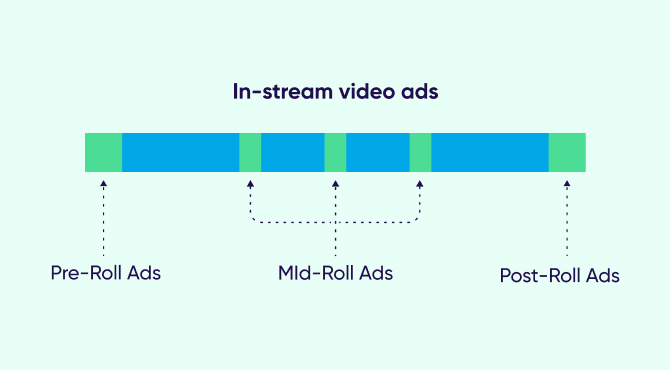
CTV (Connected TV)
Connected TV, or CTV for short, is a device that can access content via the internet, including on streaming services, social media platforms, and internet browsers.
What is CTV?
CTV (short for connected TV) refers to a device that connects to the internet and can stream content through streaming services, internet browsers, and social media. CTV devices include smart TVs and gaming consoles like Xbox and Playstation, as well as Fire Sticks, Apple TV, and other streaming-specific devices.
Unlike traditional TV, CTV allows advertisers to accurately measure viewing behavior, clicks, and conversion rates, while making it easy for consumers to watch their favorite shows on multiple devices. It’s a win-win.
What’s the difference between CTV and OTT?

These acronyms are sometimes confused, but they refer to two separate things.
Connected TV is the physical device that connects to the internet and streams content. Over-the-top, or OTT for short, specifically refers to the content and streams that are being shown on a connected TV.
In short, CTV shows OTT content.
What are the benefits of CTV advertising?

CTV is growing more popular with advertisers as privacy changes in a post-IDFA world are making campaign measurement harder than ever before. Not only does CTV help you reach the right audiences more effectively, it enables you to do this safely without having to navigate the changing rules and regulations around IDFA and cookies.
Let’s walk through a few more benefits.
Precise audience segmentation and reporting
Unlike traditional linear TV, CTV allows advertisers to reach specific audiences by demographics, interest, context, time of day, device, and geography. And with so much content available, advertisers can be confident they’re placing ads that are contextually relevant.
This improves efficiency, reduces ad waste, and ensures your ads are being shown to the most relevant audiences. It also enables more comprehensive and granular reporting, so you can optimize ad performance over time.
Show up in the right places
Large-scale advertising buys, like programmatic banner ads, come with the massive risk of showing your ads in inappropriate situations that could ultimately hurt your brand image. With CTV advertising, advertisers can be much more prescriptive about where their content will be shown, minimizing the risk of being at the wrong place at the wrong time.
Reach an ever-growing viewerbase
In 2022, 92% of American households could be reached by CTV advertising. While Gen Z and Millennials still make up the majority of the cohort, the rate of adoption has snowballed across all age brackets. This means advertisers can reach a wider audience at lower cost, and viewers can be served more relevant ads than they’d see on traditional TV.
Common CTV ad formats
While some platforms like Hulu offer a wide variety of ad formats, there are three main ones you should know about: in-stream video ads, interactive video ads, and display ads. What they all have in common is the ability to show your ad while the audience is highly engaged.
In-stream video ads

The most common form of CTV advertising is in-stream video ads, which play while the content is being watched. They typically range from 15 to 30 seconds, and can be placed before the show (pre-roll ads), during it (mid-roll ads), or at the end (post-roll ads).
In-stream video ads typically benefit from good viewing figures (measured in CPM or cost per mille), as your audience is engaged and ready to watch a video. On the flipside, they can be seen as intrusive, particularly if they interrupt the content at a crucial moment.
Interactive video ads
Next up are interactive video ads, which are exactly as they sound – ads that viewers interact with. They might do this via a clickable button on the screen, a carousel, or a QR code. These ads provide an extra layer of engagement data, but may not be available across all CTV platforms. Rakuten, Roku, and Prime Video all use interactive video ads.
Display ads
Display ads are shown on the homescreen, as an overlay, on the bottom, or on the side of the video content. They’re typically smaller and have much lower viewability than the former two ad formats. They’re usually static and have limited inventory in the streaming space.
The CTV measurement dilemma
CTV measurement is still maturing, and that means there are some teething troubles to be aware of. The most common pitfalls and challenges are to do with data fragmentation.
Making sure you’re combating fraud and getting accurate attribution across all your marketing channels is a challenge as old as time. However, working with an MMP like AppsFlyer can help you connect your data, ensuring it’s accurate and fits in with your larger media planning strategy.
Key takeaways
- Connected TV (CTV) is a device that accesses the internet to stream content, such as a smart TV, streaming stick, or gaming console.
- CTV is the physical device, while over-the-top (OTT) refers to the content streamed on a connected TV.
- CTV allows advertisers to accurately measure viewing behavior and engagement, while making it easy to stream on any device for viewers.
- CTV advertising’s biggest strength is its precise audience segmentation and data reporting.
- CTV advertising allows advertisers to reach a wide and growing viewer base, with the potential for cheaper and more relevant ads compared to traditional TV. However, there are still some teething troubles, primarily around data fragmentation and attribution.



